Janet Hendy explained that she had been a member of Trumpington Women’s Institute (WI) for 18 years and President for 10 years.
The impetus for the foundation of the WI came from Canada and from one woman in particular, Adelaide Hoodless, whose fourth child had died from an illness caused by drinking contaminated milk. She felt women should be better informed about domestic matters and she spent her life working for domestic science lessons to be introduced into schools. Adelaide was one of a group of women who founded the Hamilton branch of the Young Women’s Christian Association to provide education for the working classes and unskilled women. As a result of this, the first WI was formed at Stoney Creek. Adelaide became the President of the Stoney Creek WI.
The first UK Women’s Institute was formed in Wales in 1915, the first branch being in Llanfair PG. The idea quickly spread across England and Wales and was a natural extension of the suffrage movement. The aims were different from those in Canada, with meeting places being set up to provide a centre of information for women who were involved in all departments of public and professional work.
It was suggested that the WI could be expanded by attracting farmers’ wives to come along, but these ideas were met with indifference and suspicion. Country women knew their place and had no intention of stepping out of line. In one village the Vicar had forbidden women to venture out after dark! Another village felt it dangerous to take women away from the kitchen sink. Who knew where it might lead? Any women who did come sat in silence and did not partake in any discussions.
Later on in 1915 things got moving. A lady called Marge Watt had worked tirelessly to get the WI off the ground was asked to speak at the Agricultural and Horticultural Union meeting in Llanfair PG. Word of this meeting spread and within two years 187 branches had been formed, with membership of just over 3,000.
Lady Denman was the first National Chairman. Gertrude Mary Denman was born in 1884 and was Assistant Honorary Director of the Women’s Land Army from 1917-1919. This experience allowed her to draw on a carefully cultivated network of country women to help set up the WI. She worked tirelessly with her band of women through the 1920’s and 1930’s to put the WI on the map. Because of its agricultural origins, it retained the thread of interest in food production and rural crafts and expanding the educational horizons of its members to prepare them for their new role as full citizens of the country.
The first National AGM of the WI was held on 16th October 1917; the second in 1918 was attended by 500 delegates.
Many of the leading lights of the WI had been active members for women’s rights to vote, including Lady Denman. Other members of the first committee included Millicent Fawcett (the wife of Henry Fawcett, who is buried in Trumpington Churchyard). A plaque has recently been installed by his grave, and it is well worth a visit. The committee wanted to encourage its members to become politically aware. Most of the women who founded and ran the WI at national and local level were suffragettes and they deplored the use of force.
After the First World War, women over 30 had been granted the vote. Many women turned to the WI as a way of educating, informing and supporting women.
Initially the WI was exclusively rural. When women in towns wanted to form institutes, the National Federation of Women’s Institutes (NFWI) decided they should concentrate on rural issues, and, with the support of the NFWI, Townswomen’s Guilds were formed in 1928.
During the Second World War, the WI played a major part in keeping the country running. The Land Army was set up to help produce and harvest food, volunteers were busy making jam and chutney to help feed the nation. During the war, Lady Denman used a lot of petrol in the course of her work, and rations were limited to 1,800 miles a year, with extra for war work. Having applied for extra coupons she was refused, so she wrote to Lord Woolton, Minister of Food, saying that if she did not get extra coupons she would need to resign and the institutes would draw the conclusion that the government did not place any value on their national efforts. The petrol coupons were immediately made available to her, illustrating the power of the WI! Lady Denman retired as President in 1945.
The WI at Sandringham was set up in 1919 with Queen Mary as President. Our Queen became a member in 1943 when she was still Princess Elizabeth. On Queen Mary’s death in 1953, our Queen took over as President at Sandringham.
At the end of the war, Queen Mary gave a vote of thanks to the WI for the part they had played in keeping the country going, thanking Lady Denman particularly for all the WI had achieved under her leadership, hoping she realised the deep gratitude and affection which members felt for her. Lady Denman had just told the executive committee that she would not be seeking re- election as chairman and they would have to elect someone else. She suggested Lady Diana Albermile, who was a member of the executive committee.
By 1946, there were 6326 institutes with a membership of 303,000. The winter of 1947 is well remembered for the snow and ice. Snow in 1947 prevented a speaker arriving at a meeting in Staffordshire. Showing a high level of lateral thinking, two ladies left the meeting, killed a chicken and plucked it, and another member demonstrated how to dress a chicken!
After 1945, life for many women changed, more were in paid employment. One of the tasks post war was not to just build housing stock after the bombing but to reconstruct family life. By this reckoning women should be back in the homes being good housewives, producing lots of children and giving them a good upbringing. Before the Second World War women made up only 10% of the workforce, but in 1943 a survey showed that 75% of women wanted to keep their professional jobs.
The Home and Country magazine, which was distributed monthly to all members, started carrying a regular column by Philip Harben, who was the first celebrity chef on TV. He had been invalided out of the RAF with an eye injury and drafted into the catering corps, by 1942 he started compering a BBC radio cookery programme, and by 1946 he had moved to TV. He wrote many cookery books until his death in 1970. So it was something of a coup for the WI to get him to write for them. He made heavy use of dried egg and sardines. One idea was to drain the oil off of a tin of sardines, mix it with two teaspoons of HP Sauce and fry the sardines in this mix and serve them on toast as devilled sardines!
A monthly magazine is still distributed to all members under the title of WI Life .
The WI became involved in various fund raising and campaigns. One example was raising funds for local hospitals but in 1948 the NHS was established and so there was no need for fund raising. Another example was a national survey of earth closets undertaken in 1949. Many villages were without proper water supplies and sanitation. In Great Eversden, the school had a bucket system with no doors! The teacher used the same facilities, and she had to lock the children in the school while she used the conveniences which were in full view of the school. It was discovered that one school in Cheshire had a cess pit which had not been emptied for 17 years!
With the establishment of the welfare state, women had gained what the WI had campaigned for during the years before the war. The WI became involved in campaigning for better treatment for children’s diseases and health care generally.
The WI was ideally situated to collect information about living conditions in the countryside. In 1956, a questionnaire was sent out by the WI about housing, water supplies, sewerage and electricity, home help services, and outpatient issues, bus services, footpaths and provision of litter bins. Results were published in a booklet called Our Village and copies were circulated to MP’s, councillors, the Chief Constable, etc.
The ‘Keep Britain Tidy’ campaign was started by the WI during the 1950’s.
After the war it was felt that the WI needed its own centre to run courses for women wanting to improve their skills in needlework, crafts, cookery, etc. After much searching and fund raising a house was found at Marcham in Berkshire, then occupied by the RAF. After much refurbishment, it was finally opened on September 14th 1948 and was named ‘Denman College’ after Lady Denman who had just retired as President of the WI .
The national AGM was taking place at the Albert Hall that summer and it was decided to transport the 750 delegates to view Denman College and report back to their institutes about the facilities on offer. The husband of a member, who had been in charge of troop movements on the Clyde during the war, offered to organise this. So 24 coaches in groups of 3 each transporting 32 passengers carrying a colour coded ticket, set off from London to Denman College. Each person was allowed 2 ½ hours to look around, eat a meal and then board the coach for the return journey! Quite an achievement. How things have changed – the first courses were 15 shillings for full board and tuition fees, current fees are around £350 for a two day course!
The Women’s Institute is the largest women’s organisation in Britain with 205,000 members. It has recently opened 112 new branches. Each branch is linked to other WI’s in their area, and they keep in touch through a county magazine which is distributed monthly to all members.
The anthem linked to the WI is ‘Jerusalem’, the words of which were written by William Blake in 1816, and were set to music by Hubert Parry in 1916. It was originally written for a concert on behalf of the Right to Fight movement, but Parry became disillusioned with this movement and finally withdrew his support. The song was then taken up by the Women’s Suffrage movement, and following a concert at which it was performed, Millicent Fawcett asked if it could be used at a Suffragest Demonstration concert and become the Women Voters hymn, Parry was delighted! When the suffrage societies folded in 1928, Parry’s executors reassigned the copyright to the WI.
Janet Hendy
This paper includes information about the Women’s Institute movement and a brief history of Trumpington Women’s Institute. It was given to the meeting of the Local History Group on 12 March 2020, one hundred years after the founding of Trumpington Women’s Institute.
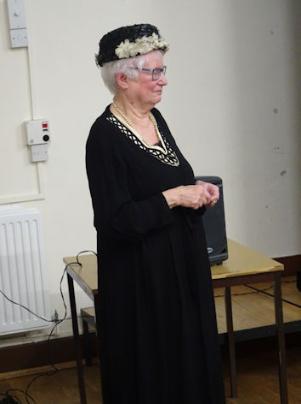
Janet Hendy speaking about the history of the Women’s Institute. Photo: Andrew Roberts, 12 March 2020.
Trumpington Women’s Institute
Trumpington WI was founded in 1920, 5 years after the first WI was established, with Mrs Patience Pemberton as President. She remained President until 1929. Meetings were held in the Village Hall, and we have continued to meet there for 100 years. For additional information, see the page of photographs from the Trumpington WI Archive .
Trumpington currently has 34 members who regularly contribute to events in the village, e.g. Seedy Sunday, the School Fete, Church Christmas Tree Festival, etc. Members make ‘Twiddle Mitts’ for dementia sufferers, and crocheted poppies, greeting cards and preserves, etc.
In 1927, the Trumpington WI Banner was completed by members. The border was designed by the Cambridge Tapestry Industry. The shield of Sir Roger de Trumpington was copied from the famous brass in Trumpington Church. This brass is the 2nd oldest in the country. The tassels and cord were handmade. The whole banner was traced out and made by 122 members.
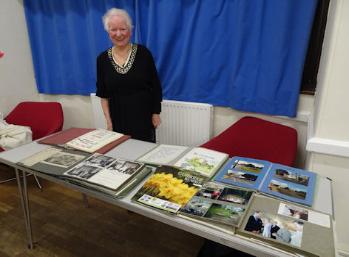
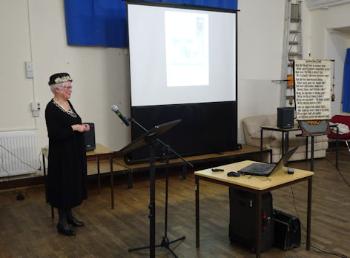
Janet Hendy speaking about the history of the Women’s Institute. Janet is wearing clothes and shoes that had belonged to the great aunt of her husband, Michael Hendy, which the great aunt had worn in the 1940s. She had farmed in Devon and been a longstanding member of the Slapton WI. Photo: Andrew Roberts, 12 March 2020.
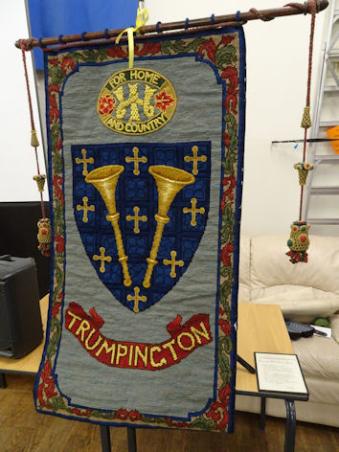
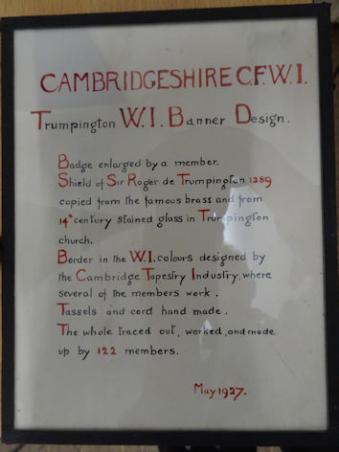
The Trumpington Women’s Institute banner, on display at the meeting. Photo: Andrew Roberts, 12 March 2020.
Mrs Pemberton was succeeded by her daughter Mrs Viola Pemberton (the mother of Sir Francis Pemberton) in 1929. She undertook a round the world trip between November 1952 and June 1953, travelling by air, sea, train and road. She was over 70 at the time and travelling solo, stopping off to give talks to WI groups on the way. Quite an achievement! Members of Trumpington WI organised a welcome home party which was attended by over 100 members.
In 1953, one member, Miss Margaret Pollack, was lucky enough to win a reserved seat for the Coronation on June 2nd. A full account of this is given in a scrapbook.
Trumpington WI had a very large committee during the 1950’s and 60’s, something like 18-20 members. It also had a flourishing drama group and a choir, who staged many productions for members of the public
Membership of Trumpington Branch grew rapidly and by 1960 there were 133 members.
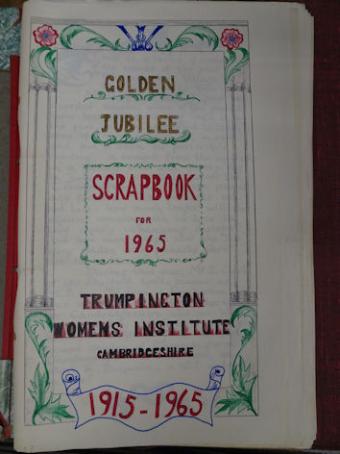
Trumpington Women’s Institute Golden Jubilee Scrapbook, 1965, on display at the meeting. Photo: Andrew Roberts, 12 March 2020.
Cambridge Federation has always occupied a central office, and in the early days it was in Warkworth Street, Cambridge, behind the police station. It then moved to temporary accommodation at Penn Farm, Haslingfield, before taking up permanent residence in a purpose built building at Girton. This was officially opened by Prince Edward in 2006.
In 1968, our own Audrey King was elected County Federation President, and one of her first jobs was to introduce Richard Baker, BBC TV announcer, as the main speaker at the County AGM.
Trumpington WI has had many talented people over the years, including:
Mrs Tudor – an expert in rush work
Mrs Bullman – black thread embroidery
Miss Willers – glove making and toys
Mrs Woolfenden – embroidery
Mrs Norman – corn dollies
Mrs Peggy Newell – many crafts but mainly spinning; she had 3 spinning wheels. Peggy and her husband Eddie gave demonstrations at agricultural and other shows.
Jean Arnott, Maureen Harris and Mary Pitman were all expert flower arrangers who gave their talents to Trumpington Church
Jane Brookes, elected Chairman of Cambridgeshire County Council in 1987.
The Presidents of the Trumpington WI have included:
1920 to 1950 Mrs Patience Pemberton, Mrs George Foster, Mrs Heley, Mrs Bird, Mrs Peck and Mrs Viola Pemberton
1966 Mrs Viola Pemberton retired and succeeded as President by Mrs Mary Chown
1968 Vice-President and County Federation Chairman Mrs Audrey King
c. 1970 Mrs Mary Chown succeeded as President by Mrs Sylvia Lowe
President and County Federation Chairman Mrs Sylvia Lowe
1973-81 Mrs Audrey King
1981-82 Mrs Enid Stocks
1982-90 Mrs Audrey King
2000-10 Mrs Maureen Harris
2010-present Mrs Janet Hendy
Trumpington WI celebrated its centenary in February 2020, with a tea party and entertainment on February 6th. Members wore hats of various colours and sizes, which added to the atmosphere! Our oldest member is Audrey King, aged 96, who has been a member since 1954. She held the office of President and Secretary of Trumpington WI for many years and was also County President for several years. Audrey attended the party, and when asked to cut the cake she agreed, but said she would not say anything. However, Audrey started reminiscing and Michael Hendy eventually had to put the knife into her hand to get the cake cut!
At the end we all stood and sang Jerusalem, which used to be sung at every meeting, but now is reserved for special occasions.
We now meet on the first Thursday of each month, in the Village Hall at 2.15 pm, why not come along and meet like minded women as we go forward into our second century!
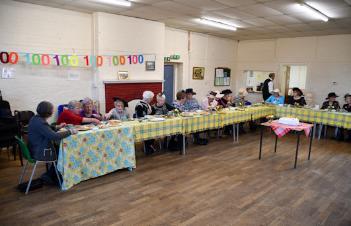
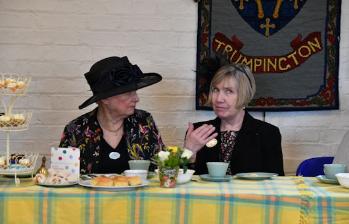
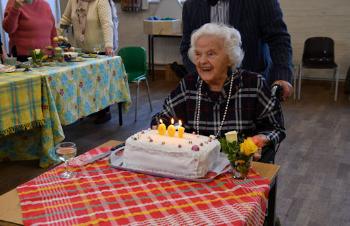
Trumpington Women’s Institute (WI) centenary tea, Jubilee Room, Trumpington Village Hall. Photo: Edmund Brookes, 6 February 2020.
Audrey King at the Trumpington Women’s Institute (WI) centenary tea. Photo: Edmund Brookes, 6 February 2020.
Janet Hendy, President of Trumpington Women’s Institute, and Sally Kingman, Chairman of the Cambridge Federation of Women’s Institutes, at the Trumpington Women’s Institute (WI) centenary tea. Photo: Edmund Brookes, 6 February 2020.